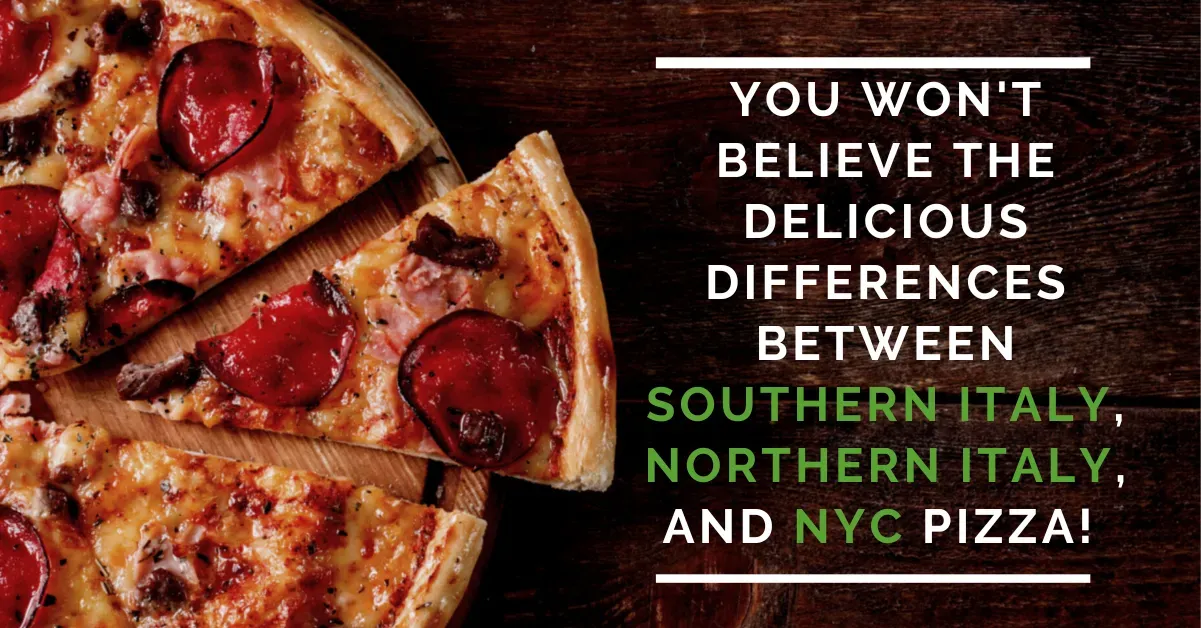A Tale of Three Pizzas: Southern Italy, Northern Italy, and New York City
Pizza is a universally beloved food, but did you know there are different styles of pizza depending on where you are in the world? From thin and crispy to thick and doughy, pizza varies greatly depending on its place of origin.Whether you're a pizza connoisseur or a casual fan, you'll learn something new about this beloved food as we explore the differences between these distinct styles.
Italian Pizza
The Origin: Southern Italy
Naples: The Birthplace of Pizza
Naples, a vibrant city in the Campania region of Southern Italy, is widely recognized as the birthplace of pizza, one of the world's most beloved foods. The history and tradition of pizza in Naples are rich and deeply ingrained in the city's culture.
Origins: The history of pizza in Naples dates back to the 18th or early 19th century. It was initially a food for the poor, a simple and affordable dish that could be eaten on the go.
Pizza Marinara: One of the earliest forms of pizza was the Pizza Marinara, topped with tomato, garlic, oregano, and olive oil. It is named 'Marinara' not because it contains seafood but because it was traditionally prepared by the seafaring wives for their husbands when they returned from fishing trips.Pizza Margherita: The most famous story of Neapolitan pizza involves Queen Margherita of Savoy's visit in 1889. A local pizzaiolo (pizza maker), Raffaele Esposito, created a pizza representing the colors of the Italian flag: red (tomato), white (mozzarella), and green (basil). This pizza was named Pizza Margherita in honor of the queen.
Traditional Craft: Naples' pizza-making is considered an art form, with time-honored techniques and recipes passed down through generations.
World Heritage Recognition: In 2017, UNESCO added the art of Neapolitan 'Pizzaiuolo' to its list of Intangible Cultural Heritage of Humanity, acknowledging its cultural and culinary importance.Strict Standards: True Neapolitan pizza must adhere to specific ingredients, preparation, and cooking standards. This includes using San Marzano tomatoes, Mozzarella di Bufala Campana, hand-kneaded dough, and baking in a wood-fired oven.
Distinctive Style: Neapolitan pizza is known for its soft, chewy crust, slightly charred and puffy edge (cornicione), and flavorful but not overloaded toppings.
Wood-Fired Ovens: The cooking method is essential. Pizzas are cooked at high temperatures in wood-fired ovens for just a few minutes, giving them a unique flavor and texture.Local Ingredients: The emphasis on fresh, local ingredients is a hallmark of Neapolitan pizza, reflecting the culinary ethos of the region.
- Thin crust
- Simple, fresh ingredients
- Margherita: tomatoes, mozzarella, basil, olive oil
- Marinara: tomatoes, garlic, oregano, olive oil
- Cooked in wood-fired ovens
- High heat for a short time
- The crust is soft and slightly charred
Northern Italy's Take on Pizza
Pizza in Northern Italy has distinct characteristics, reflecting the region's unique culinary traditions and local ingredients. While Southern Italy, particularly Naples, is often celebrated as the birthplace of pizza, Northern Italy offers its own variations and styles that are notable in their own right.Characteristics of Northern Italian Pizza
Crust: The crust of Northern Italian pizza tends to be thinner and crisper than classic Neapolitan pizza. In some areas, it is almost cracker-like in texture. This is partly due to the different types of flour used and the baking techniques.Sauce: Tomato sauce may be less prevalent in Northern styles, with some pizzas opting for a white base (pizza bianca) or creamier sauces.
Size and Serving: In some parts of Northern Italy, pizza may be served more as a personal dish than the more giant, shareable pies common in other regions. This aligns with the general European approach to pizza as an individual meal.
Baking Method: Wood-fired ovens are still used, but you might also find more modern cooking methods. The temperature and cooking time can vary, affecting the texture and flavor of the pizza.
Gourmet and Artisanal Approach: There is a growing trend in Northern Italy for gourmet and artisanal pizzas, with chefs experimenting with high-quality, locally sourced ingredients and unique combinations to create more upscale and innovative dishes.
Regional Variations
Piedmont and Lombardy: These regions often feature pizzas with richer cheeses and meats, reflecting their dairy and agricultural production.
Regional Variations
- Venice: pizza al trancio (square slices)
- Bologna: crescentina (deep-fried pizza dough)
- Rome: pizza bianca (no tomato sauce)
- Thicker crusts
- More bread-like texture
- Hearty, filling
Gourmet Flavors and Local Ingredients
- Emphasis on regional specialties
- Truffle
- Prosciutto
- Gorgonzola
- Creative combinations
- Fig and goat cheese
- Pear and gorgonzola
- Pumpkin and pancetta
New York City: The Pizza Capital of America
New York City is often hailed as the Pizza Capital of America, a title reflecting its deep-rooted and enduring love affair with this iconic dish. The city's pizza landscape is rich, diverse, and steeped in history, making it a pivotal location in the American pizza scene.Characteristics
- Large, thin, foldable slices
- Perfect for on-the-go eating
- The crust is crispy on the outside and soft on the inside
- Generous toppings
- Classic: pepperoni, sausage, mushrooms, onions
- Specialty: chicken parmigiana, meatballs, spinach, and ricotta
- Tomato sauce
- The slightly sweet, tangy flavor
- Rich, thick consistency
- Cooking Method
- Gas ovens
- Cooks pizza more evenly
- Longer cooking time than wood-fired ovens
- Lombardi's: America's first pizzeria
- Established in 1905
- Classic Neapolitan-style pizza
- Di Fara: Brooklyn institution
- Made-to-order
- Signature combination of mozzarella, parmesan, and fresh basil
- Joe's Pizza: a Greenwich Village staple
- Perfect New York slice
- No-frills, classic flavors
- Annual events
- Showcasing pizzerias from all five boroughs
- Competitions for the best slice
In conclusion, pizza is an incredibly diverse and delicious dish that has evolved over time to suit different regional preferences. While Neapolitan pizza from southern Italy may be the original, northern Italy and New York City have each developed unique styles that are equally beloved?
Whether you crave a classic Margherita's simplicity or a gourmet slice's indulgence, there is a pizza for everyone. So, go ahead and explore the world of pizza – your taste buds will thank you!
Caprese Pizza: Italian vs. New York Style
While both Caprese pizzas are mouthwateringly delicious, some key differences exist between the Italian and New York styles.
| Italian Style | New York Style | |
|---|---|---|
| Crust | Traditionally, Italian Caprese pizza features a thin and crispy crust, allowing the toppings to shine. | New York-style Caprese pizza usually has a hand-tossed, slightly thicker crust with a chewy texture. |
| Sauce | Italian Caprese pizza often uses a light tomato sauce or even fresh tomatoes, letting the flavors of the toppings take center stage. | Tomato sauce is more generous in New York-style, adding a rich flavor to the pizza. |
| Cheese | Fresh mozzarella cheese is a must in the Italian version, adding a creamy texture and subtle taste. | While fresh mozzarella is still an option, New York-style may use shredded mozzarella or a blend of cheeses. |
| Toppings | Tomatoes, fresh basil leaves, and a drizzle of olive oil are the classic toppings, representing the colors of the Italian flag. | New York-style Caprese pizza can be more varied, often including additional vegetables and toppings. |
Both versions celebrate the delightful combination of tomatoes, mozzarella, and basil, but the variations in crust, sauce, cheese, and toppings create distinct and mouthwatering experiences.
What is Breakfast Pizza?
Breakfast pizza is a creative and delicious twist on traditional pizza designed to cater to morning tastes. Unlike regular pizzas for lunch or dinner, breakfast pizzas are topped with ingredients commonly found in a hearty breakfast.
The base is often a standard pizza dough, but it is topped with breakfast staples such as scrambled eggs, bacon, sausages, ham, and cheeses.
Some variations may include unconventional bases like a hash brown crust or a flaky pastry dough. Vegetables such as spinach, tomatoes, and onions are also famous for adding freshness and a healthful touch.
This dish combines the beloved elements of breakfast with the universal appeal of pizza, making it a favored choice for brunch or a lazy weekend morning.
How is Breakfast Pizza Different in New York and Italy?
Contrastingly, in Italy, where pizza has a profoundly traditional and regional history, breakfast pizza (if available) tends to be simpler and focuses on high-quality, fresh ingredients. Italian breakfast pizzas might feature thinly sliced prosciutto, a scattering of arugula, and a light sprinkle of cheese, often mozzarella or ricotta, on a thin, crisp crust.
The approach enhances the dough's flavor and texture with minimal toppings that speak to Italian culinary sensibilities. It is often enjoyed in a more casual or family-style setting.
These variations highlight the regional adaptations of pizza, transforming it from a classic dinner staple into a versatile breakfast delight that caters to local tastes and ingredients.>
Source & Credits:
https://pizzaneed.com/pizza-types/
(getButton) #text=(Yellow and Pink Foods: Delights for Your Taste) #icon=(link) #color=(#8134af) (getButton) #text=(Reasons Why Falafel Is Significant On Your Diet) #icon=(link) #color=(#348498) (getButton) #text=(Health Benefits with the Vibrant Rainbow Diet) #icon=(link) #color=(#2339bd) (getButton) #text=(Spice Up Your Kitchen With Thai Dishes!) #icon=(link) #color=(#dd2a7b)




